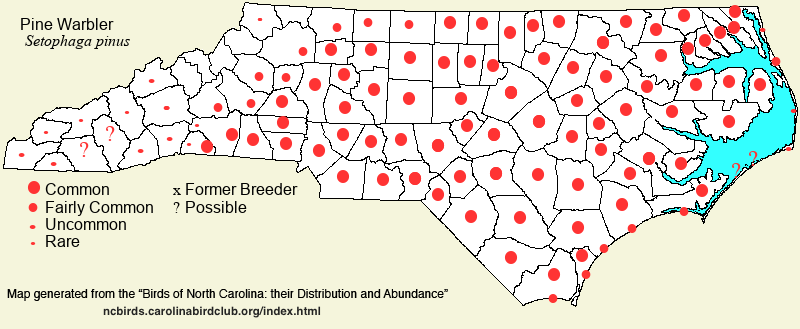 |  |
|
Pine Warbler - Setophaga pinus PARULIDAE Members: | Search Common: Search Scientific: |
|
|
|||||||
| General Comments | The Pine Warbler is certainly the best-named warbler species, as it is almost always found in pine trees. (Many warblers are badly misnamed -- named for cities or states where first collected, or perhaps in vegetation where first collected -- e.g., Tennessee, Nashville, Cape May, Connecticut, Magnolia, and Palm.) It breeds only in the eastern half of the country, but within part of this range, including North Carolina, it is one of the more abundant songbirds and is the dominant breeding species in pine forests. Hardly any mature pine stand in the Coastal Plain and Piedmont is without a pair or two of them. It does not nest, however, in quite a few of the mountain counties, as suitable stands of pines are rare to absent. It also is the second-most common wintering warbler in the state (next to Yellow-rumped). At all seasons it is found in mature to middle-aged stands of Longleaf, Loblolly, Shortleaf, Pond, or Virginia pines -- favoring the first two species. It also nests in residential areas with mature pines, at golf courses, and in other pine-dominated groves. In winter, Pine Warblers are usually found in mixed species flocks with chickadees and titmice; however, many birds instead gather in flocks with Eastern Bluebirds and Chipping Sparrows, often feeding on the ground, even in plowed fields! | ||||||
| Breeding Status | Breeder | ||||||
| NC BRC List | Definitive | ||||||
| State Status | |||||||
| U.S. Status | |||||||
| State Rank | S5B,S4N | ||||||
| Global Rank | G5 | ||||||
| Coastal Plain | Permanent resident, with migratory movements. Common to very common breeder across the region, being very common in the southern portions (including the Sandhills) dominated by Longleaf Pines. Does breed on the Outer Banks, unlike most warblers. In winter, common in the most of the Coastal Plain, especially from Croatan National Forest southward, and in the Sandhills. Mostly fairly common in the northern half of the region in winter, but can be common by late Feb or early Mar. Peak counts: | ||||||
| Piedmont | Permanent resident, with migratory movements. In summer, common to very common in the eastern and southern portions, common in the central portions, but only fairly common in the northwestern portions. In winter, fairly common to common along the eastern and southern portions, but decreasing in abundance westward, to uncommon in the northwestern portions. In all areas, more numerous in summer than in winter. Peak counts: 311, Jordan Lake spring count, 7 May 2000. | ||||||
| Mountains | Summer resident, and sparse winter resident at lower elevations. In summer, fairly common in the extreme southwestern corner (such as in Cherokee), but uncommon (essentially below 2,500 feet) north to about the French Broad River valley. Essentially absent north of Buncombe, except at the base of the Blue Ridge Escarpment; however, quite a surprise was an adult with two recently fledged juveniles seen at New River SP (Ashe) on 13 Jun 2023. In winter, rare in the lower elevations, and few perhaps survive the winter. Peak counts: | ||||||
| Finding Tips |
None needed. **** | ||||||
| Attribution | LeGrand[2023-10-20], LeGrand[2023-04-08], LeGrand[2012-10-02] | ||||||
| NC Map Map depicts all counties with a report (transient or resident) for the species. | Click on county for list of all known species. |
| NC Breeding Season Map Map depicts assumed breeding season abundance for the species. |  |